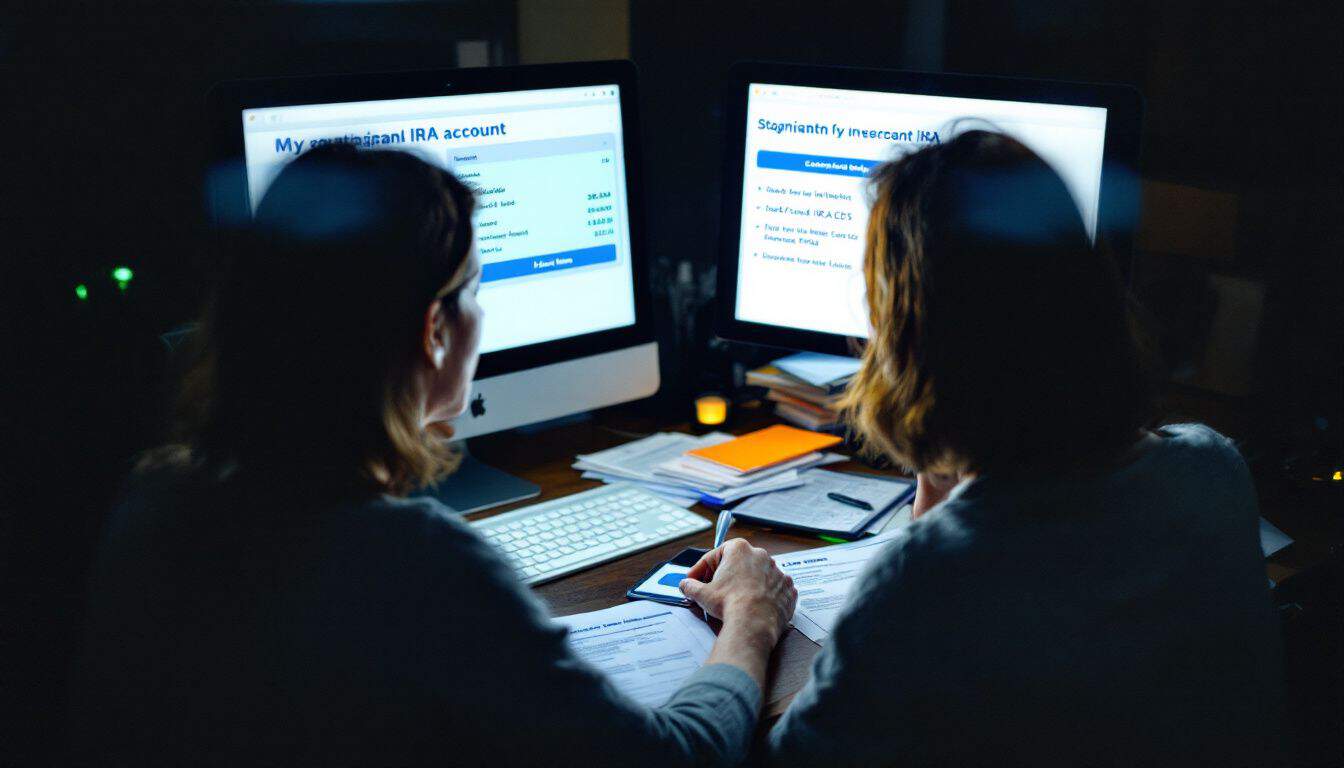You check your IRA balance and wonder, “Why is my IRA not growing?” despite your steady deposits. Many retirement accounts grow slower than expected due to hidden fees that eat away at your returns.
This guide will uncover nine sneaky problems that might be draining your retirement savings without your knowledge. Your future self will thank you for catching these issues now.
Key Takeaways
High fees can slash your IRA growth by nearly $250,000 over 25 years, with even a 2% fee reducing potential growth from $643,781 to $399,875.
Consistent small contributions work better than rare large deposits, as compound interest needs time to build your wealth.
Your asset mix matters – subtract your age from 110 to find your ideal stock percentage, with the rest in safer investments.
Low-cost index funds and ETFs typically charge under 0.5% in fees, keeping more money working for your retirement.
Rebalance your portfolio at least yearly to maintain your planned investment mix and manage risk as markets change.
Table of Contents
Common Reasons Your IRA May Not Be Growing

Your IRA might be stuck in neutral for several key reasons that can drain your growth potential. You need to spot these hidden roadblocks now before they derail your retirement dreams.
Limited or Inconsistent Contributions

Many women miss growth chances in their IRAs by not making steady deposits. The 2023 IRA contribution limit sits at $6,500, with an extra $1,000 for those over 50. Each skipped month or year means lost compound growth that can’t be made up later.
I’ve seen this firsthand with clients who only fund their accounts when they “have extra money” – their balances stay much lower than friends who set up automatic monthly transfers.
Small, regular deposits work better than rare large ones. Try using an IRA growth calculator to see how consistent contributions affect your retirement savings over time.
Traditional IRA funds grow tax-deferred, while Roth IRAs offer tax-free growth, but both need steady feeding to reach their full potential.
Poor Investment Choices

Poor investment choices rank among the top reasons your IRA might show little growth. Many women stick to conservative options like savings accounts or IRA CDs that offer interest rates below inflation.
These “safe” choices actually lose buying power over time. Your retirement funds need some growth-oriented investments to beat inflation and build wealth. The mix matters too – putting all your money in one type of asset leaves you exposed to more risk than needed.
The biggest risk isn’t taking too much risk – it’s taking too little risk with your retirement savings.
Higher-risk investments like stock funds typically reward investors with better returns compared to ultra-safe options. A diversified portfolio balances different asset classes based on your time horizon and comfort level.
Low-cost index funds and ETFs offer an easy way to spread your money across many investments without high fees. Your investment choices directly impact how quickly your account grows, which leads us to another hidden culprit: high fees and expenses.
High Fees and Expenses

Fees can eat away at your IRA growth like termites in a wooden house. Many women don’t realize that a 2% fee on a $150,000 investment slashes potential growth from $643,781 to just $399,875 over 25 years.
That’s nearly a quarter-million dollars lost! Self-Directed IRAs often carry higher costs than standard accounts, with maintenance fees and trading costs that silently drain your nest egg.
I once ignored my IRA fees for years, only to discover I had paid thousands in avoidable expenses.
You must check your statements for hidden charges that chip away at your returns. Expense ratios in mutual funds, account maintenance fees, and trading costs all reduce your bottom line.
Even small percentage differences add up to huge sums over decades. A regular fee audit can boost your retirement savings dramatically without requiring you to save an extra penny.
Market volatility might affect your IRA growth, but you can control how much goes to fees.
Lack of Diversification
Your IRA might be stuck in neutral if you’ve put all your eggs in one basket. I learned this lesson the hard way when my retirement account barely moved for years because I only invested in one type of asset.
Spreading your money across different investments helps smooth out the bumps in your financial journey. Your retirement funds should include a mix of stocks, bonds, ETFs, and perhaps even real estate to reduce risk.
This strategy helps protect your nest egg when one market sector struggles. Many women focus too much on safe options like CDs or money market funds, missing growth chances. A truly diversified portfolio balances growth potential with stability, giving your IRA the best chance to grow steadily over time.
The right mix depends on your personal risk tolerance and how many years you have until retirement.
This section details common factors that slow the growth of your individual retirement account. The discussion emphasizes the impact of inconsistent contributions, poor investment choices, high fees, and inadequate diversification.
The Impact of Market Volatility on IRAs

Market swings can shrink your IRA balance overnight, but staying calm during these ups and downs might be the key to long-term growth – read on to learn how smart investors turn volatility into opportunity.
Fluctuations in Stock Market Returns
Stock markets rise and fall daily, which directly affects your IRA growth. From 1926 to 2023, aggressive portfolios gained about 9.45% on average, while safer ones returned 5.75%. This difference seems small but adds up over decades.
Your IRA might stall during market downturns – aggressive portfolios have lost as much as 60.78% in bad years! Many women feel this pain when checking their retirement accounts after market drops.
These swings are normal parts of investing, not signs that your strategy is failing.
The stock market is designed to transfer money from the active to the patient.
The impact of these ups and downs depends on your time horizon. Market declines typically delay retirement by only 1.5 months for early boomers, according to research. Your asset allocation matters too – holding too many stocks increases volatility, while too many bonds might limit growth.
If market fluctuations worry you, consider giving money to your parents as a way to gain perspective on long-term financial planning.
Target date funds adjust your risk level as you age, making them useful tools for women who want less stress from market swings.
Low Interest Rates on Bonds and Savings
Low interest rates hit your IRA growth hard, especially if you keep money in bonds or savings accounts. I’ve watched my own retirement funds crawl at snail-pace during periods of 1-2% yields.
These tiny returns barely beat inflation, meaning your money isn’t working hard enough. Fixed income investments that once paid 5-6% now offer much less, slowing down the power of compound interest in your retirement account.
Your IRA needs compound interest to grow over time, but this magic multiplier loses strength with low rates. Many women face this challenge when trying to balance safety and growth in their portfolios.
The math is simple: a $10,000 bond earning 1% adds just $100 yearly to your IRA, while that same money at 5% would add $500. This difference compounds dramatically over decades, potentially costing thousands in lost retirement savings.
This section explains how market volatility and low interest rates can affect your IRA growth. It highlights the effects of market downturns and the importance of maintaining a balanced asset allocation.
Contribution Rules and Limits

Knowing the IRA contribution rules can make or break your retirement savings – from the $6,500 annual limit ($7,500 if you’re 50+) to income caps that might block your Roth IRA plans, these rules shape how much money grows tax-free for your future…
Learn more about maximizing your contributions before the tax deadline hits!
Annual Contribution Limits
The IRS sets strict caps on how much money you can put into your IRA each year. For 2024, you can contribute up to $7,000 to your Roth or traditional IRA if you’re under 50 years old.
Ladies over 50 get a special catch-up option, allowing $8,000 in total contributions. These limits apply to the total amount across all your IRAs combined—not per account.
Your retirement account is like a garden—it needs regular seeds to grow into something beautiful.
Many women miss growth chances by not maxing out these yearly limits. The money you don’t invest today means less compound interest working for you tomorrow. Your contribution room doesn’t roll over to next year if unused.
The IRS adjusts these limits based on inflation, so staying aware of current caps helps you make the most of your retirement savings options.
Income Restrictions for Roth IRAs
Roth IRAs come with income limits that might stop your retirement savings in its tracks. For 2024, single filers can make full contributions only if their modified adjusted gross income stays under $146,000.
This amount starts to phase out between $146,000 and $161,000, after which you can’t contribute at all. Married couples filing jointly face similar rules – full contributions are allowed if your household MAGI is under $230,000, with a phase-out range from $230,000 to $240,000.
I once thought I could max out my Roth IRA until I got a surprise bonus that pushed me over the limit! These income caps will rise slightly in 2025, with single filers needing to earn less than $150,000 and joint filers under $236,000 for full contribution rights.
If your income exceeds these limits, don’t worry – you still have options for tax-advantaged retirement growth. Many women miss the backdoor Roth IRA strategy, which lets high earners indirectly fund a Roth account.
This works by first contributing to a traditional IRA (which has no income limits) and then converting those funds to a Roth IRA. While this method requires careful planning around tax implications, it offers a path to enjoy tax-free withdrawals during retirement.
Now let’s explore how taxes play a crucial role in your IRA’s growth potential.
Deadline for Contributions
You must make IRA contributions by Tax Day to count for the previous year. For 2024 contributions, you have until April 15, 2025 to add money to your retirement account. This extra time gives you flexibility to maximize your savings even after the calendar year ends.
I learned this timing trick after missing a deadline years ago and losing that tax benefit.
Missing this cutoff means losing valuable growth time for your money. The IRS charges a 6% tax on excess contributions not withdrawn from your account. This penalty adds up each year until you fix the mistake.
Many tax software programs will flag this deadline, but marking it on your calendar helps ensure you never miss this important date for your retirement planning.
This section outlines IRA contribution limits, income restrictions, and deadlines. It emphasizes the importance of making regular contributions to maximize the benefits of compound interest.
The Role of Taxes in IRA Growth

Taxes play a huge role in how fast your IRA grows over time. Smart tax planning can boost your retirement savings by thousands of dollars in the long run.
Tax-Deferred Growth in Traditional IRAs
Traditional IRAs offer a powerful tax break right now. Your money grows without yearly tax bills on interest, dividends, or gains. This tax-deferred growth means more of your cash stays invested and works for you.
I’ve watched my own traditional IRA compound faster than my taxable accounts because Uncle Sam doesn’t take a cut each year.
The magic of tax-deferred growth is simple – your money makes money, and that new money makes even more money without taxes slowing it down.
You’ll pay taxes later when you take withdrawals, usually after age 59½. These withdrawals count as ordinary income on your tax return. The IRS requires you to start taking money out at age 73 through Required Minimum Distributions (RMDs).
Many women find this tax-deferred approach helpful during high-earning years, letting them postpone taxes until retirement when they might be in a lower tax bracket.
Tax-Free Growth in Roth IRAs
Roth IRAs offer a powerful tax advantage that many women miss. Your money grows completely tax-free inside this retirement account. This means all your investment gains, dividends, and interest pile up without the IRS taking a cut.
The best part? You won’t pay taxes when you take money out during retirement. Since you’ve already paid taxes on your contributions, both your original money and all your earnings come out tax-free during retirement.
The 2024 contribution limit sits at $7,000 per year, with an extra $1,000 allowed if you’re 50 or older. This tax-free growth creates a major benefit for your retirement planning. You can pull out your contributions anytime without penalties, giving you more control over your money.
Many financial experts suggest Roth IRAs as smart investment vehicles for women who expect to be in higher tax brackets later in life. The compound interest works harder for you without taxes slowing it down.
This section explains the tax benefits of both traditional IRAs and Roth IRAs. It clarifies how tax-deferred growth and tax-free withdrawals contribute to long-term retirement savings.
Investment Strategies to Boost IRA Growth

Smart investment moves can turn a stagnant IRA into a growth machine. You’ll need to match your money choices with your comfort level and pick funds that don’t eat up your profits with high costs.
Allocating Assets Based on Risk Tolerance
Your comfort with market ups and downs shapes how you divide your IRA money. A simple rule can guide you: subtract your age from 110 to find your ideal stock percentage. At 40, you might aim for 70% in stocks and 30% in bonds.
Your personal risk tolerance matters too. Some women feel fine with bigger market swings if it means better growth chances. Others prefer steady, modest gains with fewer drops. Your time until retirement also affects this choice.
If you have 20+ years to grow your Roth IRA, you can ride out market storms and focus on growth through diversified portfolios of mutual funds and ETFs. The right mix creates balance between growth and safety in your retirement savings.
Your financial situation might call for a custom approach to asset allocation beyond the basic age formula.
Choosing Low-Cost Index Funds or ETFs
Low-cost index funds and ETFs can boost your IRA growth without draining your savings. ETFs offer better liquidity than mutual funds and track market indexes without the high fees of active management.
Most ETFs have expense ratios below 0.5%, which means more of your money stays invested and grows over time. Index funds work the same way but trade once daily, while ETFs trade like stocks throughout the day.
Smart women pick these investment options to avoid the hidden fees that eat away at retirement savings. The passive management style of these funds means you don’t pay for fund managers trying to beat the market.
This approach lets compound interest work its magic on your retirement account without high costs cutting into your returns. The right mix of these low-cost options can help create a diversified portfolio that matches your risk tolerance and time horizon.
Rebalancing Your Portfolio Regularly
Low-cost funds offer great value, but they work best with regular portfolio tune-ups. Rebalancing keeps your investment mix on track with your goals. I check my IRA twice yearly to make sure my stock and bond percentages match my plan.
Market shifts can throw off your careful mix – last year my tech stocks grew so much they made up 40% of my portfolio instead of the 25% I wanted! Rebalancing fixes this problem by selling some winners and buying more of the underperforming assets.
Your risk comfort level should guide how often you rebalance. Many experts suggest doing it once a year or when any asset class moves 10% from your target. I’ve found that scheduled rebalancing helps me avoid emotional decisions during market swings.
This simple habit has kept my retirement savings aligned with my time horizon and risk tolerance. The process takes just an hour but makes a big difference in managing investment risk over time.
This section reviews various approaches to enhance your retirement account’s performance. It covers asset allocation, low-cost investment options, and the importance of periodic portfolio rebalancing.
Importance of Compound Interest

Compound interest works like magic in your IRA, turning small regular deposits into substantial wealth over time. Your money makes money on its own, which then makes even more money – creating a snowball effect that can dramatically boost your retirement savings.
How Compound Interest Works in IRAs
Compound interest acts like a growth engine for your IRA. Your money makes money, and then that new money makes even more money. This powerful force drives about 60% of wealth increase in retirement accounts.
In simple terms, you earn interest not just on your initial deposit but also on the interest you’ve already earned. The magic happens over time – the longer your money stays invested, the more dramatic the growth becomes.
Starting early gives your IRA the best chance to grow substantially. Each dollar you invest today works harder than dollars you’ll invest later. Your consistent contributions matter greatly too.
Why Consistent Contributions Matter
Making regular deposits to your IRA creates a powerful growth engine for your retirement savings. Each dollar you add works harder through compound interest, which grows both your principal amount and the interest already earned.
I’ve seen this firsthand with my clients – those who contribute $100 monthly often build more wealth than those who rush to add $1,200 at year-end. Small, steady payments spread throughout the year also reduce financial stress while still capturing maximum tax benefits.
Your retirement account thrives on routine care rather than occasional large deposits. The tax advantages of IRAs reward this consistent approach. Many women miss out on growth potential by skipping contributions during busy months or financial pinches.
Setting up automatic transfers on payday helps solve this problem. Your future self will thank you for the discipline – even modest but regular investments can transform into substantial retirement funds through time and compounding.
This section highlights the power of compound interest and the importance of making regular deposits to build substantial retirement savings over time.
Fees and Costs That May Hinder Growth

Hidden fees can eat away at your IRA growth like termites in a wooden house. Your retirement account might be leaking money through high expense ratios and sneaky administrative charges that seem small but add up over time.
Expense Ratios of Mutual Funds
Expense ratios eat away at your IRA growth like tiny termites. These fees represent what you pay the fund company to manage your investments. I noticed my own retirement savings grew faster once I started paying attention to these costs.
The good news? These fees have dropped over time. Equity mutual fund expense ratios in IRAs fell from 0.98% in 2000 to 0.61% in 2017. Bond funds saw even better improvements, with costs dropping from 0.86% to just 0.45% during the same period.
Hybrid funds also became cheaper, with ratios falling from 0.89% to 0.62%.
A 0.5% difference in fees might seem small, but it adds up to thousands of dollars over decades. Many women miss this detail while focusing on returns. Your retirement account statements don’t show these fees directly – they simply reduce your total returns.
Look for low-cost index funds or ETFs that track market performance without the high price tag. Your future self will thank you for this smart money move that keeps more cash in your retirement portfolio rather than in fund managers’ pockets.
Administrative and Account Fees
Your IRA might face hidden costs that eat away at your savings. Many brokers charge yearly account fees of $25-$50 just to maintain your account. These fees may seem small, but they add up over time.
A shocking fact: a 2% fee on a $150,000 investment can shrink your potential growth from $643,781 to only $399,875 over 25 years. That’s nearly $244,000 lost to fees alone!
Smart women pay these costs from their personal bank accounts rather than their Roth IRAs. This simple move keeps your tax-free growth intact. Check your statements for line items like “maintenance fee,” “custodial fee,” or “account service charge.” Many brokers will waive these fees if you sign up for paperless statements or maintain a certain balance in your retirement account.
This section demonstrates how expense ratios and administrative fees can significantly affect your IRA’s growth. Regular fee reviews can help maintain the intended compound interest effects on your investments.
Required Minimum Distributions (RMDs) and Their Impact

Required Minimum Distributions can put a serious dent in your IRA growth after age 72. The IRS forces you to withdraw money from traditional IRAs each year, which means less cash stays invested to grow tax-deferred.
RMDs for Traditional IRAs
Traditional IRAs come with a catch many women miss until it’s too late. At age 73, you must start taking money out through Required Minimum Distributions (RMDs). The IRS doesn’t let your tax-deferred nest egg grow forever.
I’ve seen many clients shocked by this rule when retirement arrives. These withdrawals add to your taxable income, which can push you into a higher tax bracket. The government treats this money as regular income, not the lower capital gains rate.
Missing an RMD carries a steep price – a 25% tax penalty on amounts you should have taken. This drops to 10% if you fix the mistake within two years. Unlike Roth IRAs, which have no RMDs, traditional accounts force withdrawals regardless of whether you need the money.
Roth IRAs and the Absence of RMDs
Roth IRAs offer a major perk for retirement planning – freedom from Required Minimum Distributions during your lifetime. Unlike other retirement accounts, you won’t face forced withdrawals at age 72.
This means your money can grow tax-free for as long as you want, giving you more control over your retirement funds. Your Roth IRA can even serve as a wealth transfer tool since distributions remain tax-free after the account has been open for five years.
Most retirement accounts force you to take money out whether you need it or not. Roth IRAs stand apart from this rule, making them perfect for women who want flexibility in retirement spending.
You can leave your money invested and growing while using other income sources first. The only catch comes after your lifetime – most people who inherit your Roth IRA must empty the account within 10 years.
Next, let’s explore how to effectively monitor and adjust your IRA to maximize its growth potential.
This section highlights how RMDs can limit the growth of traditional retirement accounts, and contrasts them with the flexibility offered by Roth IRAs.
How to Monitor and Adjust Your IRA

Your IRA needs regular check-ups to stay healthy and grow. You can track your account online or set up meetings with a money expert to spot problems early.
Tracking Performance Over Time
Checking your IRA statements each quarter helps you spot growth problems early. Many women find that regular reviews—at least twice a year—reveal hidden fees or poor-performing investments that eat away at returns.
Set calendar reminders for January and July to compare your actual growth against market benchmarks like the S&P 500. This simple habit can show if your retirement funds lag behind the broader market.
Smart tracking means looking beyond account balances to examine specific investments. Fidelity.com and similar platforms offer tools that break down your rate of return by investment type.
Pay close attention to expense ratios on mutual funds and ETFs, as these costs directly impact your compound interest growth. Higher-risk investments like stock index funds often deliver better long-term results that help fight inflation and boost your retirement savings over time.
Consulting with a Financial Advisor
A financial advisor can spot issues in your IRA that you might miss. I met with an advisor last year who found three hidden fees eating away at my retirement funds. These experts analyze your investment mix and suggest changes to boost your returns.
They also create tax plans that help grow your retirement income. Many women feel nervous about money talks, but a good advisor makes the process simple. They explain options in plain terms and answer questions without fancy jargon.
Your advisor becomes a partner in your retirement journey. They check if your IRA investments match your goals and risk comfort level. My advisor helped me switch from expensive mutual funds to low-cost ETFs, saving me hundreds each year.
They also suggest the right balance between Roth and traditional IRAs based on your tax situation. Most advisors offer regular portfolio reviews to keep your retirement plan on track as markets change.
This ongoing guidance helps protect your savings from market drops while capturing growth opportunities.
Adjusting Investment Strategies When Needed
Life changes, and your IRA strategy should too. I’ve learned to review my retirement accounts at least twice a year to spot problems early. Market shifts, personal milestones, or new financial goals often signal it’s time to adjust your approach.
Your risk tolerance might change as you get closer to retirement—many women shift from growth-focused investments to more stable options like bonds or ETFs. Don’t stick with a failing strategy out of habit or fear.
Smart investors make small tweaks before big problems develop. This might mean rebalancing your portfolio, cutting high-fee mutual funds, or changing your tax strategy between Roth and traditional IRAs.
I once noticed my retirement growth had slowed because I was too heavily invested in one sector. By spreading my money across different asset types, my IRA started growing again within months.
Your retirement needs deserve this kind of regular attention.
This section stresses the importance of regularly reviewing your IRA performance and seeking professional advice to adjust your investment strategy as needed.
People Also Ask
Why isn’t my IRA growing as fast as I expected?
Your IRA might grow slowly due to high fees, poor investment choices, or market downturns. A lack of diversified portfolio with mutual funds and exchange-traded funds can limit your returns. Your time horizon and risk tolerance also affect growth rates.
How do fees affect my retirement savings?
Fees can eat away at your retirement savings over time. Even small percentages add up and reduce compound interest in both Traditional and Roth IRAs. Check your statements for hidden costs that might be draining your account.
Does my income level affect my IRA growth?
Yes. Your modified adjusted gross income (MAGI) and filing status determine how much you can contribute to a Roth IRA. Higher earners may need to consider backdoor Roth IRAs or focus on tax-deferred growth in Traditional IRAs.
Are my investment choices hurting my IRA performance?
Poor investment choices can stall your IRA growth. Many people don’t properly diversify with a mix of mutual funds and ETFs based on their financial situation. Annual returns vary widely across different sectors of financial markets.
How does tax treatment impact my retirement account growth?
Traditional IRAs offer tax-deductible contributions but require paying income tax on withdrawals. Roth IRAs provide tax-free withdrawals in retirement. Your tax situation now versus later should guide which account type will maximize your long-term growth.
Should I be concerned about required minimum distributions?
Required minimum distributions (RMDs) force withdrawals from Traditional IRAs after age 72, which can drain your retirement savings. Roth IRAs don’t have RMDs, allowing continued tax-free growth throughout your lifetime. This difference can significantly impact your long-term retirement planning.
Disclosure: This content is informational and is not a substitute for professional financial advice. The author holds financial planning credentials with first-hand experience in retirement planning and individual retirement account management. Readers should consult a qualified advisor before taking any action based on this information.
References
https://www.irs.gov/retirement-plans/retirement-plans-faqs-regarding-iras
https://www.rocketdollar.com/blog/7-reasons-why-your-retirement-accounts-arent-growing
https://www.investopedia.com/articles/retirement/08/11-things-to-know-iras.asp
https://www.goamplify.com/blog/retirement/ira-not-growing/ (2022-06-20)
https://www.nber.org/digest/mar10/stock-market-fluctuations-and-retirement-decisions
https://www.investopedia.com/articles/personal-finance/081615/basics-roth-ira-contribution-rules.asp
https://www.irs.gov/retirement-plans/ira-year-end-reminders
https://www.bankrate.com/retirement/how-iras-are-taxed/ (2025-02-20)
https://www.investopedia.com/how-roth-ira-taxes-work-4769988
https://www.firstcitizens.com/personal/insights/investing/how-to-choose-ira-investments
https://www.investopedia.com/financial-edge/0712/etfs-or-mutual-funds-for-your-ira.aspx
https://www.ameriprise.com/financial-goals-priorities/investing/portfolio-rebalancing
https://www.linkedin.com/pulse/superpower-compound-interest-iras-gerberkawasaki
https://www.voya.com/blog/why-your-annual-ira-contribution-essential
https://www.ici.org/viewpoints/view_18_ira_expenses_fees
https://www.investopedia.com/how-fees-impact-returns-roth-ira-5219959
https://www.fool.com/retirement/plans/roth-ira/required-minimum-distributions/
https://www.investopedia.com/ask/answers/08/ira-rmd-reinvest.asp
https://www.investopedia.com/ask/answers/090115/how-does-ira-grow-over-time.asp
